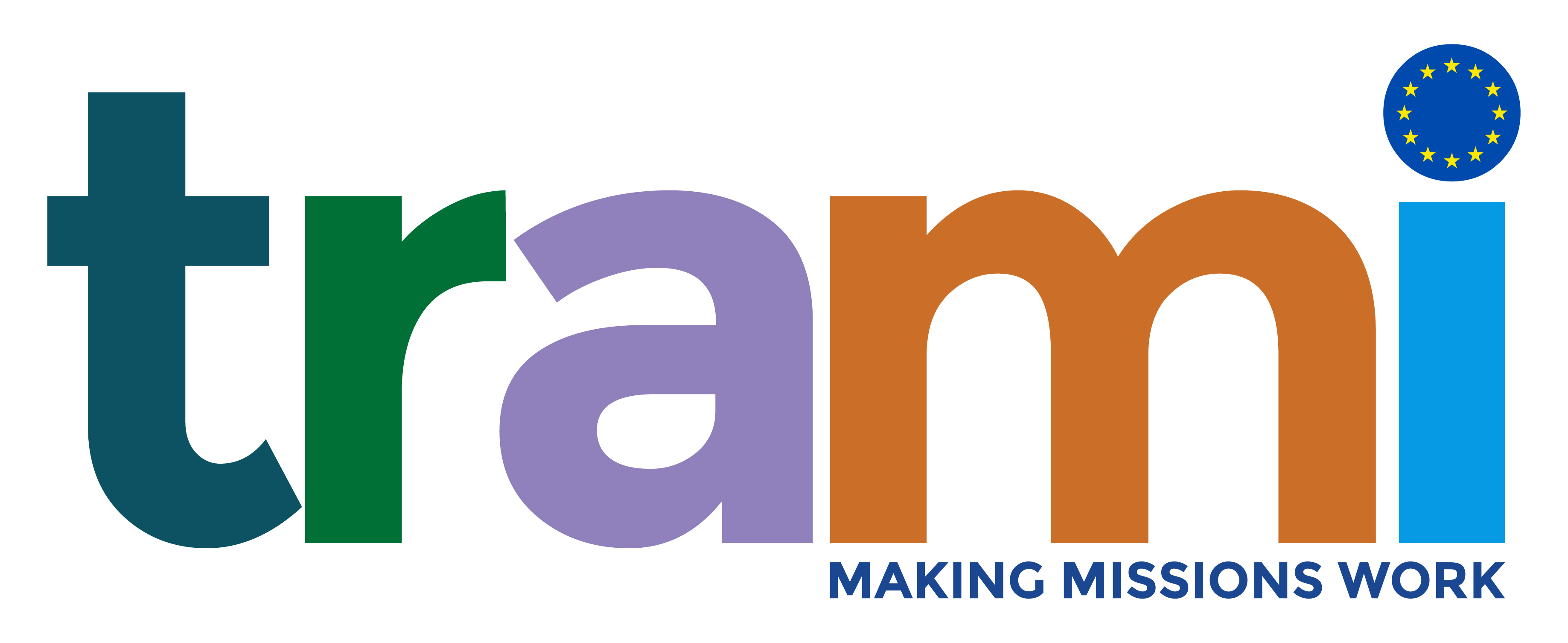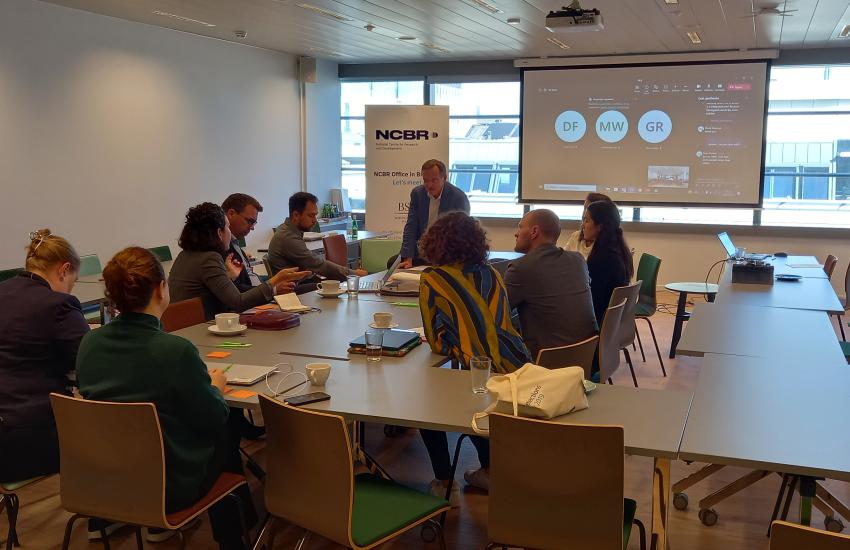Report on the first Mutual Learning Event with ERRIN
Translating EU Missions into regional policy
ORGANISERS: TRAMI and ERRIN
VENUE: NCBR Brussels Office Rue Belliard 40, 1040 Brussels, 5th Floor
DATE: 18 October 2022 10h00 to 13h00, in person
Introduction
TRAMI’s mutual learning events provide an opportunity to share experiences, learn from other stakeholders in different regions, and countries. It supports the development of governance structures, implementation strategies and integration approaches to enable the implementation of the missions at regional and national level across Europe. Regions are identified as a key stakeholder in the implementation of many of the missions, and ERRIN representing 120 regional organisations from 20 European countries is a vital link between the missions and the regions. TRAMI (WP3) and ERRIN co-created the mutual learning event titled ”Translating EU Missions into regional policy”.
Objectives of event
to facilitate the development and spreading of good practice and approaches in relation to the implementation of the EU missions at regional level and the integration into regional policy.
Attendees
Approx. 50 people - Primarily ERRIN members, representing 35 different European regions.
TRAMI consortium members and ERRIN secretariat facilitated and documented the discussions.
Methodology
Working in collaboration with ERRIN, they identified a select group of their members who they invited to the event. An overview of the TRAMI project was provided, followed by four presentations of examples of integrating missions into regional operations. After the presentations the participants were allocated to breakout groups to address a series of key questions, these groups were moderated. The summary below details the output of the groups.
- TRAMI overview – Wolfgang Polt - Joanneum Research, Austria, and Lisa Almesjö -Vinnova, Sweden
- Presentations
- Daniel Sköld, Region Blekinge, Sweden
- Françoise Guaspare, Region Île-de-France, France
- Bogdan Chelariu, North-East Romania Regional Development Agency, Romania
- Miia Paananen, Turku-Southwest Finland European Office, Finland
Summary – outputs of breakout groups
The key outputs from the four breakout groups are collectively set out below under each question. Overall, there were many similarities in the opportunities and challenges identified by the different groups. Where there were new ideas, insights, and general comments, these are also captured below.
Question 1 Is your region working with EU-missions? If so, which missions?
The majority of the participating regions are in various ways working on EU Missions. In some cases, it is the regional administrations themselves who are participating, while in other cases, there are other regional actors (i.e., universities or other regional stakeholders). The missions that most regions are involved in are the Climate adaption mission and the Cities mission. The cancer mission was identified as being considered different to the others, along with oceans and soil missions too where the links to the regions are generally not well established.
Question 2 What opportunities do you see for the region if involved in the EU-missions?
Main areas where opportunities were identified include:
- Opportunities for making long-term targets, providing direction, structure, and shared goals. Missions also provide an opportunity for improved governance, and to accelerate regional strategies, policy making, and the connection to European policy.
- Opportunities for co-creation and cooperation. Engagement of different actors, stakeholders, citizens, and young people at local, European, and global level to the betterment of society through tackling of large challenges. Missions have the potential to promote regions internationally. Missions provide new hope to change the society e.g., for young people – philosophical idea based on concrete action.
- Access to funding and other resources at regional, national, and European level, and an opportunity to get more involved in Horizon Europe and other programmes, which increases visibility and connects with new stakeholders.
- Opportunity to discover and develop new methods / frameworks for innovation, boost and motivate local innovation ecosystems to address regional issues.
Question 3 How are the EU-missions integrated into your work (strategies, policies, projects, etc.)?
- In some cases, the priorities of the region can correspond to the mission’s objectives on a topical level, but often they have not been integrated on an operational level, into the strategies and policies.
- In other cases (e.g., Blekinge in Sweden), the missions have been integrated into the RIS3 and the regional funding programmes, creating a structure for the missions on the regional level. Blekinge has also developed trainings (learning forums, learning packages) on how to use S3 and the missions in the daily work. These trainings are being delivered to the local innovation ecosystem.
- In some cases, missions are more used as a framework to mobilise key stakeholders, for framing regional activities, local action plans and regional sustainability plans, and to create visibility.
- Administrations are often working on initiatives related to the missions (e.g., climate adaptation in general) but might not realise the links with the EU level missions.
- The cancer mission seems to be, in general, more difficult to integrate in regions, due to the competences of the region, while the cities and climate adaptation missions seem to be easier to link with regional strategies. This might seem a contradiction, as health and prevention are often a regional or local competence. However, the cancer mission has a strong scientific and more "top down" approach which means that the regional/local level have more difficulties to relate to it. The specific formulation of each mission is thus fundamental for its good or bad landing into the regional context – not only the topic area itself.
Questions 4 Who takes part in the work (e.g., local/regional partnership, academia, business, NGOs)?
Many actors were mentioned however so also were the challenges:
- Many actors were mentioned as involved, e.g., municipalities, transport authorities, cities, citizens, industry, clusters, local innovation ecosystem, Brussels based offices of the regions, as those involved directly in missions.
- It was mentioned that academics and research centres can be problematic to engage with at a regional level as they are already involved with other Horizon Europe projects. In addition, due to sense of urgency it would be important to engage with academic actors geared to work on research and innovation rather close to market.
- Challenges include that stakeholders focus on their local area, e.g., their own city and not Europe, and do not seem to understand how the EU-missions can in fact be beneficial at the local level. There is a general feeling that the political longer-term vision is lacking.
- Some regions experience a lack of national support, as well as a lack of interest or awareness from actors from several sectors (e.g., public, and private sector, citizens).
Question 5 What challenges / main obstacles have you encountered when working with / trying to work with missions?
- In order to be successful, the EU Missions approach should go beyond the Horizon programme. The focus is now too much on Horizon Europe projects, whereas large-scale implementation is needed to fulfil the mission targets within the timeframe (2030). R&I is needed to accelerate some aspects of this work, but we absolutely need large-scale deployment and investments.
- The EC should be aware that it was a considerable achievement to raise such a strong political mandate for the mission(s). The risk at this moment is that the missions turn into running Horizon projects instead of supporting solid political ambitions (like getting climate neutral by 2030), losing political support in the end. This again raises the challenge of achieving broader perspective than R&I, which might need some repositioning of the Missions.
- Missions is new approach that is not fully understood by stakeholders and the concept is also interpreted very differently by different stakeholders. Some perceive missions as including too much focus on research and innovation, while others perceive missions as not including enough focus on research and innovation. There is a general conception of lack of access to information (from the EU-level), but also reluctance among regional and local stakeholders to adopt new approaches and innovative ideas.
- In quite some countries, there is a lack of inter-institutional and political engagement. Local policies and regulations can also be obstacles. Thus, there is a need to strengthen synergies between different authority levels (local, regional, national).
- Some regions experience a tension between missions and smart specialisation, as the first focus on a common European agenda and the latter the specific regional strength (in at least one case – Region of Blekinge, the two have however been successfully combined).
- Many regions stress the problem with language skills – both the limited knowledge of English of public administrators and citizens (potential problems with their engagement), but also that the “EU-lingo” creates borders at the local level.
- New types of resources are needed – human as well as financial resources to implement missions are lacking. There are also discrepancies between the level of EU ambition and tools and support available.
- Missions in their current form are in many cases seen as abstract, general, and long-term, and there is a need to understand what the added value is, as well of the concrete actions and next steps needed (e.g., adaptation mission charter – what does it mean in concrete terms). Many stakeholders find there are more urgent priorities to focus on or are not aware of the benefits.
- Citizen engagement is almost everywhere a challenge, new innovative methods on how to involve citizens are still lacking, and missions are not well known at local level.
Question 6 What kind of support would your region need?
- There is a general request for more information, translation, showcasing good examples or pathways, and help to understand what the EU-missions concretely means at regional and local level.
- Specific actions mentioned were peer to peer meetings; knowledge sharing; best practice between cities and regions; Twinning or coaching regions / cities; concrete coordination and practical support to establish governance models at city and regional level; as well as assistance in promoting / marketing the benefits of the missions in an inclusive and understandable way for all possible stakeholders e.g., industry.
- Smaller regions may require more support.
- Exactly how the TRAMI project can help the regions navigate the five missions needs further exploration but clearly there is a great need for explanations, showcasing pathways and good examples, as well as providing areas for exchange and learning between different regions.
Other ideas / comments
- Mentoring learning programmes
- Citizen information events
- Identify clear steps to get involved and what to do with e.g., the mission charter.
- Need for a simple guide “how to participate” in different missions. A clear pathway is required.
- Log in to post comments

